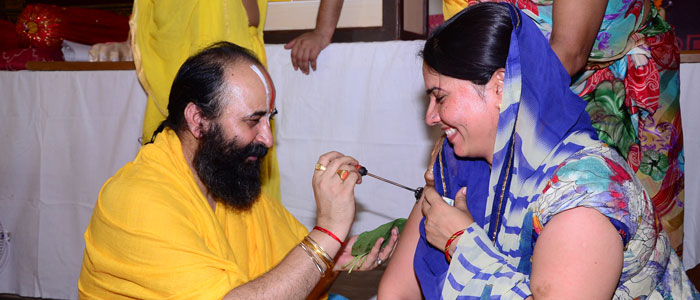Naam Daan process
It is a well-recognised keynote that any substance or being cannot be considered worthy of any action without the right sanskāra. Just as gold, for being worthy of adorning, is refined and perfected to make jewellery out of it similarly, it is important for human beings to be refined and perfected in order to be initiated into any particular act and for this our Holy Scriptures have predetermined upon sixteen sanskāras.
Apart from this, when we talk of Shrivishishta-advait-sampradaiya (society of special attributes of Monism), here five more sanskaras have been propounded in addition to the original sixteen.
On getting this human form, we are ordained with four different forms of goals i.e. dharma (duty), artha (wealth/earning), kām (desire) and moksha (salvation). And for salvation relating to realization of God, four different paths have been illustrated – these are action, wisdom, devotion and surrender. Out of these, the fourth one i.e. the path of surrender is depended upon as exemplified in Shrivishishta-advait-sampradaiya; as such a God-surrendered devotee is initiated towards five sanskaras by the spiritual preceptors.
It is only after this initiation that the devotee becomes a rightful aspirant of divine protection. The above mentioned five sankaras are as follows :
1.Tāp Sanskar (where one is made to don shankha and chakra),
2. Pundra-sanskār,
3.Nām-sanskār,
4. Mantra-sanskār,
5. Yāg-sankāra.
Tāpah pundrastathā nām mantro yāgashcha panchamah.
Ami panchaité sanskārāh param-prāpti-hétavah.
Seeking divine protection means, considering oneself completely destitute and with no other means available, surrendering on the lotus feet of the Almighty whole-heartedly with mind, body and soul. When we seek someone's protection, we tend to adorn his symbols, his sign of consecration on the forehead, his name and his mantras because we singularly belong to that devotee-loving God. He is our means and he is our goal too! With that intent, the above said sanskaras are followed in given sequence.
*sanskara means perfecting or refining of human mind or it may even notify various sanctifying or purifying rites.
The first of them being -
1. Tāp sanskār: In this sanskara, the spiritual preceptors heat up the official symbols of the Lord Almighty's armaments i.e. the conch shell and the chakra and print them on both the arms of a devotee who aspires to surrender to God. In this way, we attain Lord's symbols through this sanskara.
2. Pundrasanskar: In this sanskara, the spiritual preceptor puts a tilak or a sign of consecration of the Lord Almighty on the forehead of the seeker in a particular shape ( ōrdhwa-pundrākār) and for this only white mud found in anthills is used. In the middle of the mark, shri churna or turmeric powder is used.
3. Nām sanskār: Just as a child gets his name at the time of its birth from its father in order to get an individual identity in the same way when we enter this path of surrender and address the Almighty saying, 'O Lord! I am only and only yours', we too get the name of our Lord in order to have our individual identity. So, in this sanskara, we are given a name by our mentor from among the many names of God; like Govinda, Madhava, Krishna etc. and to that name is added Ramanujadas because after this pancha-sanskara, we get directly related to Swami Ramanujacharya. Shri Ramanujacharya is the one who founded this society and it is said that 'relation with Ramanujacharya is the key to salvation'! Since there is a tradition in the Shri Vaishnav society to consider oneself as the smallest of all and discharge duties accordingly hence the word 'das' ( meaning servant) is used. Similarly our other spiritual leaders such as Shri Yamunacharya, Shri Kulshekhar Swami and others have shown the sentiments of considering oneself as being insignificant in their stotras. Shri Kulshekhar Swami in his prayer to God says in Mukundamālāstotra,
Majjan-manah phalam-idam madhukaitbhārai matprārthaniya-madanugraha esha eva
Twadbrithya-bhritya paricharak bhritya bhritya – bhrityasya bhritya iti mām smar loknātha.
The sentiment denoted here is, "O Lord! Please be kind enough and accept me as the slave of the humblest of your slave's slave's slave's slave. In this way after obtaining the position of Lord's humble devotee the next in the chronological order comes the fourth sanskara and that is
4. Mantrasanskāra : In this sanskara our preceptors give us the mantra of Lord's name – Shri-mantra (that is the main mantra) Dwaya-mantra and Charam-mantra. All of these three mantras are associated with sentiment of seeking protection and complete surrendering at the lotus feet of the Lord. The sound judgement behind granting these mantras is that while chanting these mantras we keep aspiring for realisation of God.
5. Yāgsanskāra: In this sanskara, the mentor prays to God saying, "O Lord! This being has been grinding the mill of worldly journey till now but now he has come under your protection so please grant him deliverance. 'Nārāyana dayāsindho vātsalya-gūn-sāgar; Enam raksha jagannāth bahujanmaparadhinām.' After going through the first four sanskaras, a devotee completely gets attached to God; it is only after this that the mentor imparts him diksha (religious initiation) of Yag, which is equivalent to the practice of divine worshiping. And thus, the five sanskaras are completed.











